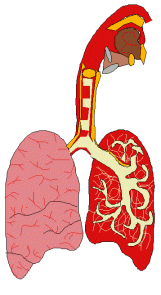|
Clinical Application |
Lung expansion therapies are primarily administered to prevent or treat atelectasis, which can occur any patient who cannot take deep breaths. These patients include those with neuromuscular disorders, those who are heavily sedated, and patients who have undergone upper abdominal or thoracic surgery.
 |
Those at highest risk for atelectisis are postoperative patients. Nearly 70% of patients who have undergone upper abdominal surgery exhibit clinical signs of postoperative atelectasis. Factors contributing to postop atelectasis include shallow breathing, a failure to take deep breaths, and a transient decrease in surfactant production. In combination, these factors can cause a progressive decrease in functional residual capacity (FRC), leading to alveolar collapse, most frequently in the basal or dependent portion of the lung. |
With perfusion remaining unchanged, the resultant V/Q mismatch causes arterial hypoxemia. These patients' pain further restricts ventilation, and the effects of the pain are compounded by the tendency to voluntarily contract or splint the muscles in the area of the surgical incision. Splinting further decreases tidal volumes, hindering deep breathing, and resulting in a decrease in ventilatory reserve as measured by the vital capacity.
Most postoperative patients also have problems coughing effectively. An ineffective cough impairs normal clearance mechanisms, and increases the likelihood of infection. Some forms of lung expansion therapy may also help improve clearance of secretions.
Patients with neuromuscular disorders which restrict use of their diaphragm also may benefit from lung expansion therapies. Loss of the normal sigh mechanism in these patients often results in a progressive loss of lung volume, a decrease in pulmonary compliance, a drop in ventilation-perfusion (V/Q) ratios, and arterial hypoxemia.